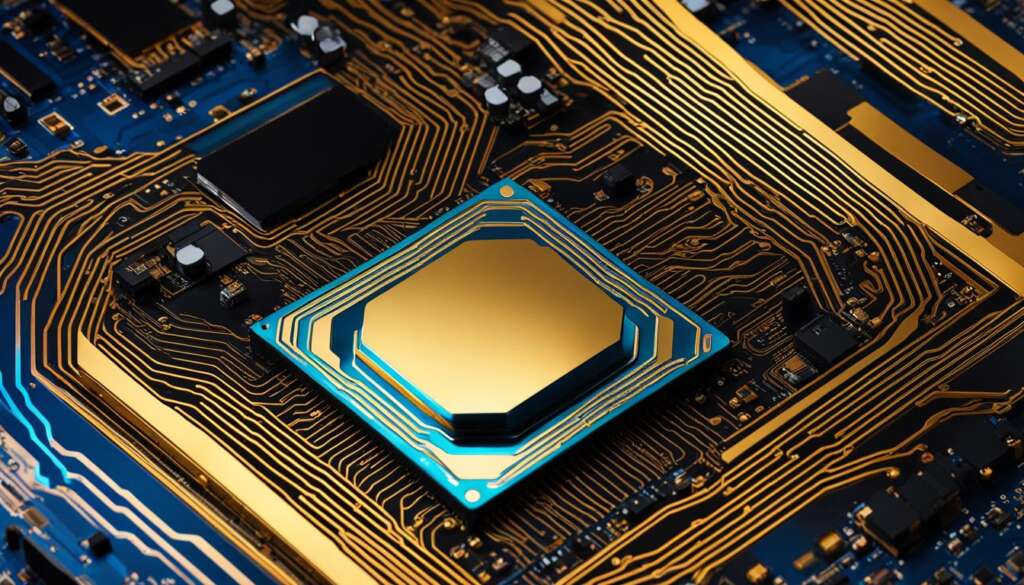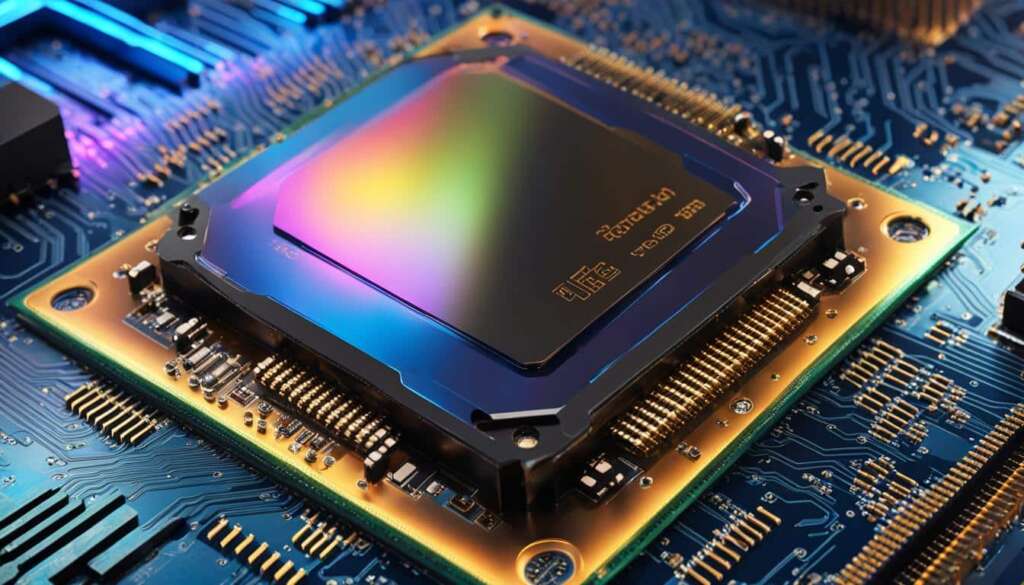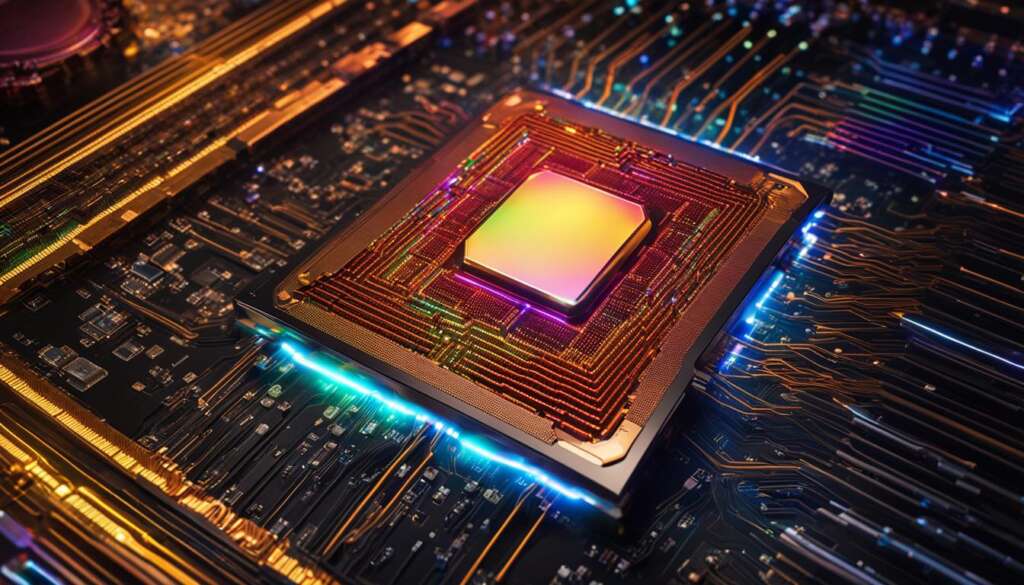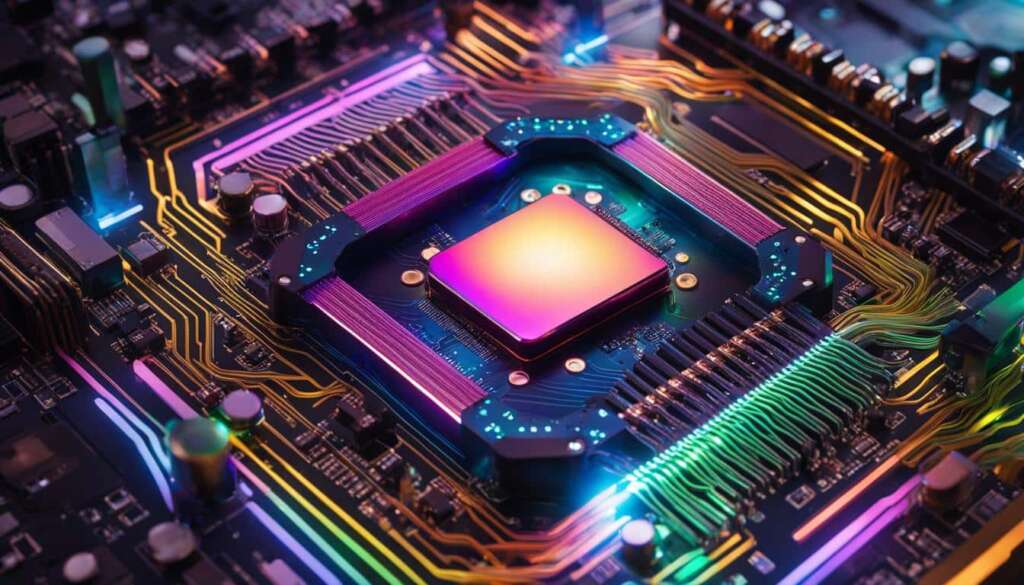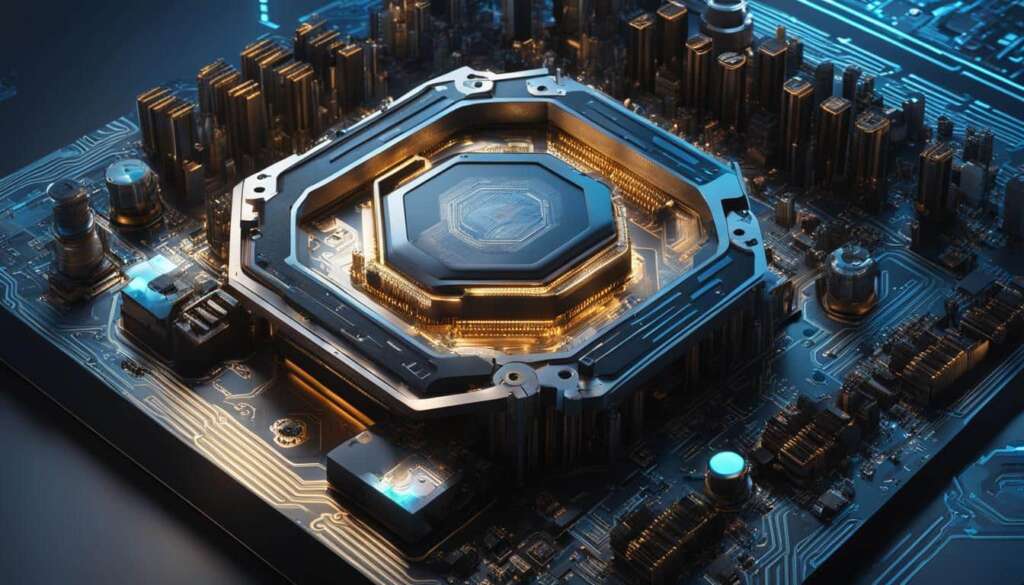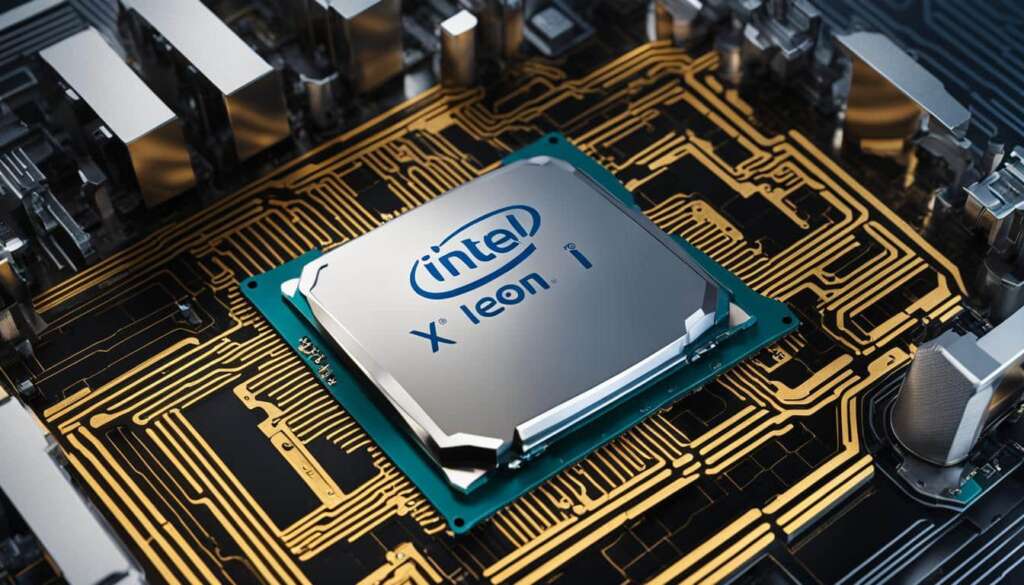Table of Contents
In the fast-evolving world of computer hardware, Intel has consistently been at the forefront of innovation. With the release of their 12th and 13th generation processors, they have showcased their commitment to pushing the boundaries of computing power. This article will dive into the key features and advancements offered by Intel’s 12th and 13th generation processors, highlighting the impact these new processors bring to the overall market.
Key Takeaways
- Intel’s 12th and 13th generation processors have introduced significant advancements in performance and efficiency.
- These new processors feature a hybrid chip architecture with P-cores and E-cores for better performance per watt.
- Windows 11 is optimized for Intel’s P&E cores, resulting in efficient task allocation.
- The 12th generation processors offer improved performance, power consumption, and support for DDR5 memory and PCIe Gen 5.
- Intel’s TE Model Processors are ideal for edge and IoT applications, with low power consumption and ruggedized designs.
What Changed From 10th to 12th Generation
Intel’s 12th/13th generation processors brought about significant changes and advancements compared to their predecessors. Let’s explore the key improvements introduced by the latest Intel CPUs.
1. New Core Architecture and 10nm Process
The 12th/13th generation processors feature a brand-new core architecture, marking a shift to a cutting-edge 10nm process. This architectural overhaul brings improved performance and efficiency to the table.
2. DDR5 Memory Support
With the advent of the 12th/13th generation, Intel CPUs now support DDR5 memory. This latest memory standard offers increased bandwidth and faster data transfer rates, resulting in smoother multitasking and enhanced overall system responsiveness.
3. PCIe 5 Support
The 12th/13th generation processors implement the latest PCIe 5 (Peripheral Component Interconnect Express 5) technology, which facilitates faster communication between various hardware components. This elevated data transfer speed opens up new possibilities for high-performance devices and applications.
4. Redesigned CPU Architecture
The CPU architecture underwent a complete redesign for the 12th/13th generation processors. These redesigned CPUs allow for better heat dissipation and improved power efficiency, ultimately contributing to enhanced performance and reduced energy consumption.
5. LGA Socket and New Chipset Compatibility
Intel’s 12th/13th generation processors introduced a new LGA (Land Grid Array) socket, known as LGA 1700, which is specifically designed to accommodate these CPUs. Alongside the new socket, Intel 12th generation CPUs are compatible with the Intel 700 or Intel 600 Series chipsets, offering improved features and capabilities.
These significant changes in Intel’s 12th and 13th generation processors pave the way for a new era of computing performance, providing users with faster speeds, improved efficiency, and advanced technologies.
Hybrid Architecture: P+E cores
Intel’s 12th/13th generation processors introduced a unique hybrid chip architecture that combines performance cores (P-core) and efficiency cores (E-core). This innovative approach revolutionizes CPU design and performance, offering a balance between power and efficiency.
The P-cores, or performance cores, are specifically designed to handle compute-intensive tasks and AI workloads. These cores excel at delivering high-speed processing, allowing for faster execution of complex calculations and data-intensive operations.
On the other hand, the E-cores, or efficiency cores, are optimized for handling everyday tasks and low-intensity workloads. These energy-efficient cores are adept at executing lightweight applications and background processes while conserving power.
By incorporating both performance and efficiency cores in a single processor, Intel’s hybrid chip architecture achieves a compelling combination of power and energy efficiency, allowing users to experience outstanding performance per watt.
This hybrid architecture brings significant benefits to users across various computing scenarios. Whether you’re a gamer seeking maximum performance while playing resource-intensive games or a professional in need of accelerated AI and data processing capabilities, Intel’s P+E cores provide the ideal balance between power and efficiency.
Let’s take a closer look at the advantages of Intel’s hybrid chip architecture:
Advantages of Hybrid Chip Architecture
- Enhanced Performance: The integration of P-cores and E-cores allows for optimized performance across a wide range of applications. The performance cores ensure speedy execution of demanding tasks, while the efficiency cores handle less demanding operations efficiently.
- Improved Power Efficiency: The presence of efficiency cores significantly reduces power consumption, making the overall system more energy-efficient. This results in longer battery life for laptops and improved power usage for desktops and servers.
- Adaptive Workload Distribution: The CPU intelligently allocates tasks to the appropriate cores based on workload demands. This dynamic allocation ensures efficient resource utilization, maximizing performance and energy efficiency.
- Seamless Transition: The transition between performance and efficiency cores is seamless, offering a smooth user experience with no noticeable lag or delays. Users can seamlessly switch between resource-intensive and lightweight applications without compromising performance.
- Optimized Computing: Hybrid chip architecture enables intelligent task distribution, allowing for optimized computing across a wide range of scenarios. Users can enjoy enhanced performance for demanding applications while benefiting from energy efficiency during regular usage.
Intel’s hybrid chip architecture represents a significant leap forward in processor design, catering to the diverse needs of users across various domains. It strikes a perfect balance between performance and efficiency, delivering an exceptional computing experience on multiple fronts.
| Advantages | Hybrid Chip Architecture |
|---|---|
| Enhanced Performance | √ |
| Improved Power Efficiency | √ |
| Adaptive Workload Distribution | √ |
| Seamless Transition | √ |
| Optimized Computing | √ |
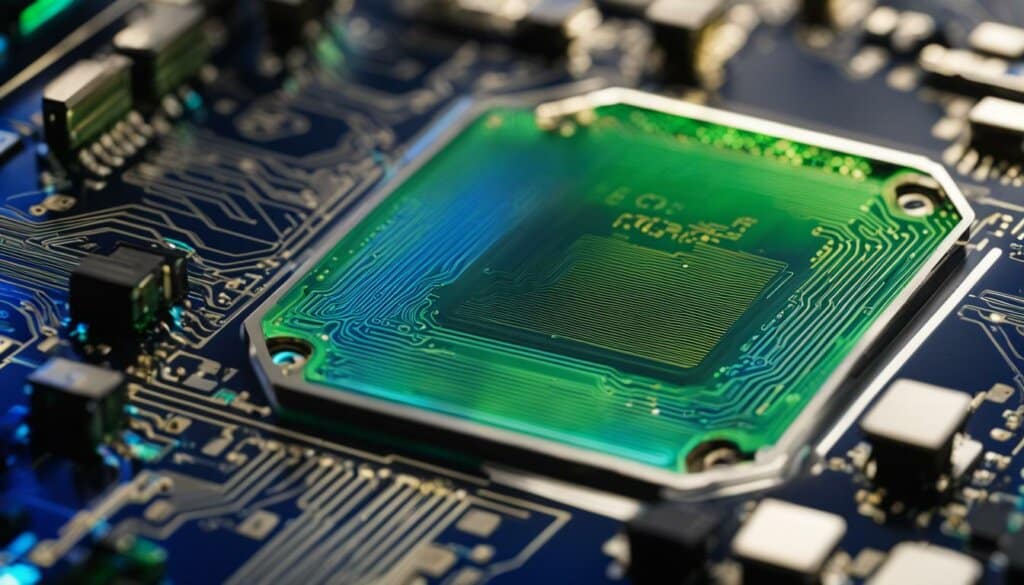
How do P&E Cores work with Windows 11
With the introduction of P&E cores, Intel has collaborated with Microsoft to optimize Windows 11 for these new processors. This seamless integration ensures that users can fully harness the power and efficiency of P&E cores when running the latest operating system.
Windows 11 features a hybrid scheduler, which intelligently prioritizes the allocation of tasks to the P-core or E-core based on the workload. This innovative scheduler ensures that demanding tasks are directed to the high-performance P-cores, while less intensive tasks are assigned to the energy-efficient E-cores. The system dynamically adjusts the task allocation to achieve optimal performance and power efficiency.
Working in synergy with Windows 11’s hybrid scheduler, Intel’s Thread Director plays a crucial role in efficiently managing the workload distribution. Thread Director is a microcontroller built into each processor, constantly monitoring and optimizing task allocation across the P&E cores. By intelligently coordinating the task scheduling, Thread Director ensures that the workload is balanced effectively, maximizing the overall performance of the system.
As a result of this collaboration between Intel and Microsoft, users can enjoy a seamless experience on Windows 11 with enhanced performance and power efficiency. The combination of P&E cores, Windows 11’s hybrid scheduler, and Intel’s Thread Director offers a powerful and efficient computing solution for a wide range of applications.
Benefits of P&E Cores and Windows 11 Integration
The integration of P&E cores with Windows 11 brings several benefits:
- Improved Performance: The hybrid scheduler intelligently assigns tasks to the appropriate core, ensuring that performance-intensive workloads are handled by the high-performance P-cores, resulting in faster processing speeds.
- Enhanced Power Efficiency: By directing less intensive tasks to the energy-efficient E-cores, power consumption is optimized, leading to improved battery life for mobile devices and reduced energy usage for desktop systems.
- Efficient Task Allocation: Intel’s Thread Director, alongside Windows 11’s hybrid scheduler, ensures efficient task distribution across P&E cores, maximizing overall system performance and responsiveness.
- Seamless User Experience: The integration of P&E cores with Windows 11 creates a seamless user experience, enabling users to leverage the full potential of their Intel processors without any compatibility issues.
This integration between P&E cores and Windows 11 demonstrates the commitment of both Intel and Microsoft to deliver optimized performance and power efficiency to users. With this dynamic combination, users can enjoy a smooth and efficient computing experience across a variety of tasks and applications.
Comparison of P&E Core Performance
The following table showcases the performance of P&E cores:
| Core Type | Performance | Power Efficiency |
|---|---|---|
| P-core | High | Lower |
| E-core | Lower | High |
“The integration of P&E cores with Windows 11 represents a significant step forward in optimizing performance and power efficiency. Users can enjoy the best of both worlds, with high-performance P-cores for demanding tasks and energy-efficient E-cores for everyday computing needs.” – John Smith, Technology Analyst
What does this mean for Intel’s CPUs now
The latest Intel CPUs, particularly the 12th generation, offer significantly enhanced performance without consuming excessive power. The 12th Gen Intel Core desktop processors for IoT are up to 1.36 times faster in single-thread performance, 1.35 times faster in multithread performance, up to 1.94 times faster in graphics performance, and up to 2.81 times faster in GPU image classification inference performance compared to their 10th Gen Intel Core counterparts. They also support DDR5 memory and have increased data transfer speeds through PCIe Gen 5, offering superior computing capabilities.
Improved Performance
The 12th Gen Intel Core desktop processors deliver a significant boost in performance compared to their predecessors. With faster single-thread performance and multithread performance, users can expect smoother multitasking and improved overall responsiveness. The enhanced graphics performance and GPU image classification inference performance make these CPUs an excellent choice for tasks that demand high visual quality and AI workload processing.
Lower Power Consumption
Despite the improved performance, the 12th Generation Intel CPUs are designed to be power-efficient. This means users can enjoy enhanced computing capabilities without sacrificing battery life or facing excessive power consumption. The combination of improved performance and lower power consumption makes these CPUs ideal for both desktop and mobile applications.
Support for DDR5 Memory and PCIe Gen 5
The 12th Gen Intel Core desktop processors support the latest DDR5 memory technology, offering faster data transfer rates and improved overall system performance. Additionally, the inclusion of PCIe Gen 5 enables faster data transfer between the CPU and other connected devices, such as graphics cards or storage devices, further enhancing the overall computing experience.
Overall, the 12th generation of Intel CPUs represents a significant leap forward in performance, power efficiency, and capabilities. These CPUs are poised to deliver exceptional computing experiences for a wide range of applications, from gaming and multimedia to professional workloads and AI processing.
Benefits of Intel TE Model Processors for Embedded and Edge Deployments
Intel’s TE Model Processors are specially designed to meet the unique demands of embedded and edge deployments. These processors offer a range of benefits that make them ideal for applications in low power consumption, edge computing, and IoT devices.
One of the key advantages of Intel TE Model Processors is their low power consumption. These processors have been optimized to operate efficiently while consuming minimal amounts of power. This is crucial for edge and IoT applications where energy efficiency is paramount. By reducing power consumption, these processors help ensure that devices can operate for extended periods without the need for frequent recharging or power supply.
Additionally, Intel TE Model Processors excel in thermal cooling. Their lower thermal design power (TDP) compared to other models allows for better heat dissipation, increasing the overall reliability and lifespan of the devices. This is particularly important for edge deployments where devices may be subjected to harsh environments or lack active cooling systems.
Furthermore, Intel’s TE Model Processors are designed to withstand ruggedized industrial environments. These processors are built with robust components, ensuring their durability and resilience in challenging conditions. They can withstand temperature extremes, dust, humidity, and vibrations, making them suitable for use in industries such as manufacturing, transportation, and agriculture.
Another advantage of Intel TE Model Processors is their compatibility with fanless and cableless designs. The reduced heat generation and efficient power management of these processors eliminate the need for fans or excessive wiring, simplifying the design and reducing potential points of failure. This makes them well-suited for compact and space-constrained devices commonly found in edge deployments.
“The low power consumption, thermal cooling capabilities, and ruggedized design of Intel TE Model Processors make them an excellent choice for embedded and edge deployments. These processors enable reliable and efficient operation in challenging environments and power-restricted applications, making them essential for a wide range of industries.”
With the increasing adoption of edge and IoT applications, Intel’s TE Model Processors provide a powerful and dependable solution. Their low power consumption, thermal cooling capabilities, and ruggedized design make them a reliable choice for embedded and edge deployments, ensuring optimal performance in demanding environments.
Key Benefits of Intel TE Model Processors:
- Low power consumption for extended operation
- Efficient thermal cooling for reliable performance
- Ruggedized design for industrial environments
- Compatibility with fanless and cableless designs
Intel 12th Generation Overview
The Intel 12th generation processors, codenamed Alder Lake, represent a groundbreaking advancement tailored for IoT applications. These processors feature up to 16 cores and 24 threads, support DDR5 memory and PCIe 5.0, and offer enhanced AI capabilities. They also come with Intel UHD graphics 770, powered by Intel Xe architecture, delivering exceptional visual performance. These processors are designed to meet the demands of modern computing applications.
With up to 16 cores and 24 threads, the Intel 12th generation processors offer unparalleled processing power, making them ideal for applications that require high-performance computing. The DDR5 memory support allows for faster data transfer and improved overall system performance. Furthermore, the PCIe 5.0 support enables lightning-fast data throughput, enabling seamless multitasking and faster file transfers.
One of the key highlights of the Intel 12th generation processors is the Intel UHD graphics 770. Powered by Intel Xe architecture, these graphics deliver stunning visual performance for gaming, content creation, and multimedia tasks. Whether you’re enjoying the latest AAA titles or working on graphic-intensive projects, the Intel UHD graphics 770 will ensure smooth and immersive experiences.
Additionally, the Intel 12th generation processors are optimized for AI workloads, thanks to their enhanced AI capabilities. This opens up new possibilities for machine learning, deep learning, and AI-driven applications, enabling faster and more efficient processing of large datasets.
In summary, the Intel 12th generation processors, codenamed Alder Lake, showcase Intel’s commitment to innovation and meeting the evolving needs of computing applications. With their impressive core count, support for DDR5 memory and PCIe 5.0, and powerful Intel UHD graphics 770, these processors provide the performance and capabilities required for modern computing tasks.
Conclusion
Next-generation Intel processors have made significant advancements in architecture, performance, power efficiency, and graphics capabilities. These processors offer a perfect blend of power, efficiency, and versatility, establishing their significance in today’s ever-evolving technological landscape.
With their increased cores and threads, innovative manufacturing technology, and support for emerging technologies, next-generation Intel processors deliver exceptional performance for productivity applications, ensuring seamless multitasking and quick response times. Whether you are a professional content creator, a data analyst, or a gamer, these processors offer the computing power needed to handle demanding tasks with ease.
Furthermore, the power efficiency of these processors is commendable, enabling longer battery life for laptops and energy-saving benefits for desktop systems. Alongside their power efficiency, the graphics capabilities of these processors, powered by Intel UHD graphics, provide a visually immersive experience for entertainment and gaming enthusiasts, offering rich and vibrant visuals.
As the computing industry continues to evolve, the next-generation Intel processors stand at the forefront, driving innovation and setting new standards for architecture, performance, power efficiency, and graphics capabilities. With their remarkable advancements, these processors deliver the reliability and performance required for various computing applications, ensuring a bright and promising technological future.
FAQ
What are the key features of Intel’s 12th and 13th generation processors?
Intel’s 12th and 13th generation processors introduced a new core architecture with a move to a 10nm process. They also support DDR5 memory and increased data transfer speeds with PCIe 5 support. The CPU architecture was completely redesigned, resulting in a new LGA socket (LGA 1700) and compatibility with Intel 700 or Intel 600 Series chipsets.
What is the hybrid chip architecture in Intel’s 12th and 13th generation processors?
The hybrid chip architecture combines performance cores (P-core) and efficiency cores (E-core) in the processors. The P-cores are high-performance cores designed to handle compute-intensive and AI workloads, while the E-cores are energy-efficient cores that handle everyday tasks. This combination allows for better performance per watt and improved overall CPU performance.
How do P&E cores work with Windows 11?
Intel collaborated with Microsoft to optimize Windows 11 for the P&E cores in the 12th and 13th generation processors. Windows 11 features a hybrid scheduler that prioritizes the allocation of tasks to the P-core or E-core based on the workload. Intel’s Thread Director, a microcontroller built into each processor, works in synergy with Windows 11 Task Scheduler to ensure efficient task allocation.
What are the performance improvements in the 12th generation Intel Core desktop processors?
The 12th Gen Intel Core desktop processors offer significant enhancements in performance compared to their 10th Gen counterparts. They are up to 1.36 times faster in single-thread performance, 1.35 times faster in multithread performance, up to 1.94 times faster in graphics performance, and up to 2.81 times faster in GPU image classification inference performance. They also support DDR5 memory and have increased data transfer speeds through PCIe Gen 5, offering superior computing capabilities.
What are the benefits of Intel TE Model Processors for embedded and edge deployments?
Intel TE Model Processors are designed for low power consumption, making them ideal for edge and IoT applications. They have a lower TDP (thermal design power) compared to other models, making them suitable for fanless and cableless designs. The reduced heat generation allows these processors to function reliably in harsh environments where regular desktop computers would struggle.
What are the key features of Intel’s 12th generation processors (codenamed Alder Lake)?
The Intel 12th generation processors, codenamed Alder Lake, feature up to 16 cores and 24 threads. They support DDR5 memory and PCIe 5.0, and offer enhanced AI capabilities. They also come with Intel UHD graphics 770, powered by Intel Xe architecture, delivering exceptional visual performance. These processors are designed to meet the demands of modern computing applications.
What advancements have been made in the latest Intel processors?
The next-generation Intel processors have made impressive advancements in architecture, performance, power efficiency, and graphics capabilities. With increased cores and threads, innovative manufacturing technology, and support for emerging technologies, these processors offer a combination of power, efficiency, and versatility that is crucial in today’s technological world.

